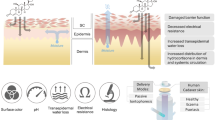Summary
ASM 981 has been developed for topical treatment of inflammatory skin diseases. It specifically inhibits the production and release of pro-inflammatory cytokines. We measured the skin penetration of ASM 981 in canine skin and compared penetration in living and frozen skin.
To make penetration of ASM 981 visible in dog skin, tritium labelled ASM 981 was applied to a living dog and to defrosted skin of the same dog. Using qualitative autoradiography the radioactive molecules were detected in the lumen of the hair follicles until the infundibulum, around the superficial parts of the hair follicles and into a depth of the dermis of 200 to 500 μn. Activity could not be found in deeper parts of the hair follicles, the dermis or in the sebaceous glands.
Penetration of ASM 981 is low in canine skin and is only equally spread in the upper third of the dermis 24 hours after application. Penetration in frozen skin takes even longer than in living canine skin but shows the same distribution.
Similar content being viewed by others
References
Helton Rhodes K., Kerdel F., Soter N.A. (1987): Comparative aspects of canine and human atopic dermatitis. Semin. Vet. Med. Surg, (small animal), 2, 166–172.
Marsella R., Olivry T. (2003): Animal models of atopic dermatitis. Clin. Dermatol., 21, 122–133.
Scott D.W., Miller W.H., Griffin C.E. (2001): Small animal dermatology, 6th Ed. W.B. Saunders. Philadelphia.
Olivry T., Sousa C.A. (2001): The ACVD task force on canine atopic dermatitis (XIX): general principles of therapy. Vet. Immunol. Immunopathol., 81, 311–316.
Queille-Roussel C., Paul C., Duteil L., Lefebvre M.C., Rapatz G., Zagula M., Ortonne J.P. (2001): The new topical ascomycin derivative SDZ ASM 981 does not induce skin atrophy when applied to normal skin for 4 weeks; a randomized, double-blind controlled study. Br. J. Dermatol., 144, 507–513.
Paul C., Graeber M., Stuetz A. (2000): Ascomycins: promising agents for the treatment of inflammatory skin diseases. Expert. Opin. Invest. Drugs., 9, 69–77.
Gupta A.K., Chow M. (2003): Pimecrolimus: a review. J. Eur. Acad. Dermatol. Venereol., 17, 493–503.
Tocci M.J., Matkowich D.A., Collier K.J., Kwok P., Dumont F., Lin S., Degudicibus S., Sierkierka J., Chin J., Hutchinson N.I. (1989): The immunosuppressant FK506 selectively inhibits expression of early T cell activation genes. J. Immunol., 143, 718–726.
Grassberger M., Baumruker T., Enz A., Hiestand P., Hultsch T., Kalthoff F., Schuler W., Schulz M., Werner F.J., Winiski A., Wolff A., Zenke G. (1999): A novel anti-inflammatory drug, SDZ ASM 981, for the treatment of skin disease; in vitro pharmacology. Br. J. Dermatol., 141, 263–273.
Mrowietz U. (2001): Ascomycin macrolactams. J. Cutan. Med. Surg., 5, 22–25.
Zuberbier T., Chong S.U., Grunow M.D., Guhl S., Welker P., Grassberger M., Henz B.M. (2001): The ascomycin macrolactam pimecrolimus (Elidel, SDZ ASM 981) is a potent inhibitor of mediator release from human dermal mast cells and peripheral blood basophils. J. Allergy. Clin. Immunol., 108, 275–280.
Stuetz A., Grassberger M., Meingassner J.G. (2001): Pimecrolimus (Elidel, SDZ ASM 981) — Preclinical pharmacologic profile and skin selectivity. Semin. Cutan. Med. Surg., 20, 233–241.
Harper J., Green A., Scott G., Gruendl E., Dorobek B., Cardno M., Burtin P. (2001): First experience of topical SDZ ASM 981 in children with atopic dermatitis. Br. J. Dermatol., 144, 781–787.
Luger T., Van Leent E.J.M., Graeber M., Hedgekock S., Thurston M., Kandra A., Berth-Jones J., Schoepf E., Thestrup-Pedersen K., Van der Valk P.G.M., Bos J.D. (2001): SDZ ASM 981: An emerging safe and effective treatment of atopic dermatitis. Br. J. Dermatol., 144, 788–794.
Stumpf W. (1976): Techniques for the autoradiography of diffusible compounds. Method. Cell. Biol., 13, 171–193.
Billich A., Aschauer H., Aszodi A., Stuetz A. (2004): Percutaneous absorption of drugs in atopic eczema: pimecrolimus permeates less through skin than corticosteroids and tacrolimus. Int. J. Pharm., 269, 29–35.
Agarwal R., Katare O.P., Vyas S.P. (2000): The pilocebaceous unit: a pivotal route for topical drug delivery. Methods Find. Exp. Clin. Pharmacol., 22, 129–133.
Harrison S.M., Barry B.W., Dugard P.H. (1984): Effects of freezing on human skin permeability. J. Pharm. Pharmacol., 36, 261–262.
Author information
Authors and Affiliations
Rights and permissions
About this article
Cite this article
Gutzwiller, M.E.R., Reist, M., Persohn, E. et al. Penetration of ASM 981 in canine skin: a comparative study. European Journal of Drug Metabolism and Pharmacokinetics 31, 53–58 (2006). https://doi.org/10.1007/BF03191119
Received:
Issue Date:
DOI: https://doi.org/10.1007/BF03191119




